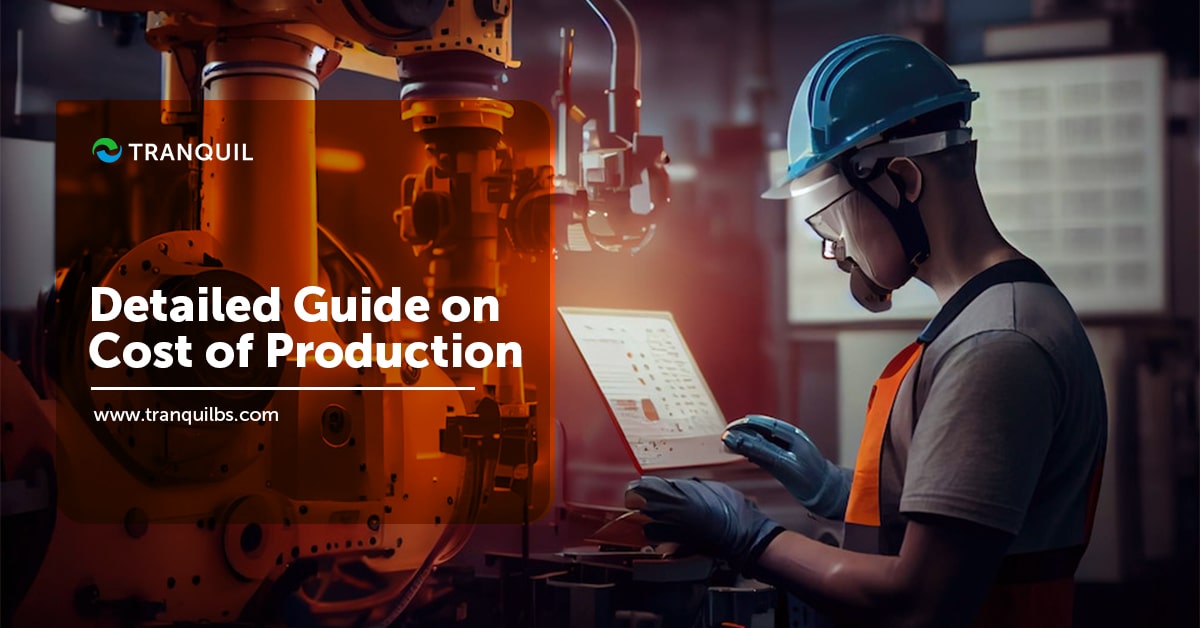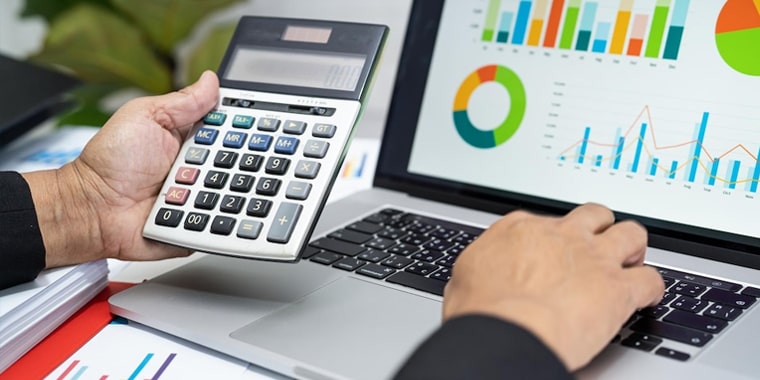
The best way to find out if you made a profit on a production order is to calculate how much it cost you to produce those goods, and deduct it from the selling price.
But what exactly is the cost of production and how do you calculate it?
To put it simply, the cost of production in the sum total of costs incurred by a company to produce products or deliver services.
Usually, production costs include raw materials and parts, labor, and so on.
ALSO READ: What is Total Cost Ownership (TCO)?
Production cost is important for businesses to evaluate their financial health; obviously, the cost must not overshoot the revenues, whether it’s a product that’s manufactured, or service that is formulated and offered.
The company may find it more sensible to discontinue the product or service, or look for ways to reduce costs.

A company incurs several types of expenses to manufacture a product or service, which are usually categorized thus:
These expenses vary according to your volume of production, rising with an increase in production, and falling with decreased production.
When there is no production, your variable cost will be zero.
Direct labor, utilities, raw materials, commissions, are all part of variable cost.
These costs are fixed regardless of whether you manufacture or not, or how much you produce.
They are fixed for a specific period – usually one month.
Salaries to employees, rent for facilities, lease paid on equipment, insurance, etc. are fixed costs.
ALSO READ: What is Landed Cost and How to Calculate It?
This is the sum total of fixed and variable costs – all expenses incurred in the production of a product or service.
If your fixed cost is SAR 2500 and variable cost SAR 6300, your total production cost would be SAR 8800.
Marginal cost looks at what it would cost to produce one more unit of product; it shows the total increase in cost because of that one product.
Variable expenses impact the marginal cost only, as the fixed cost won’t change with output level.
Marginal cost is calculated to determine resource allocation to achieve optimal profits.
They vary with volume of production.
Irregular information, price distinction, transaction costs and other external factors impact marginal cost.
This refers to the expense of producing one unit of a product.
It can be calculated in two ways:
It is desirable to have a low average cost, as it will help boost profit margins without spiking up expense.
Both these costs affect each other depending on volume of production:
ALSO READ: What is Job Costing?
When companies alter production levels according to their expected profits or loss, they accumulate long-run costs, and is mainly comprised of variable expenses.
When a company produces the largest quantity of products the most economically, it is able to sustain long-run costs efficiently.
These costs are affected by factors like growth or decline of business, altering the quantity of production, leaving a market or entering a new one, and so on.
These are costs that can be seen in real-time during production, and they are affected by revenue and variable expenses.
Short-run costs rise and fall with fluctuations in cost and rate of production.
To succeed in attaining excellent long-run costs, you must be able to manage your short-run expenses properly.
This will also help you achieve the business goals of your organization.
ALSO READ: Top 6 Benefits of Batch Scheduling
Returns to scale demonstrate how increased production is connected to the increase in inputs and differs from industry to industry.
Normally, a company has growing returns to scale when production levels are low, diminishing returns to scale when production levels are high, and constant returns somewhere mid-way.
Let’s look at the three stages in a little more detail:
This is the first stage and occurs when there is a higher output of products at diminished average per unit cost in the manufacturing process.
For example, you can procure larger volumes of materials at lower costs, and hence make a higher profit by manufacturing more goods.
This is the second stage when no change occurs in the average cost even when you produce more units.
Whenever output changes in relation to the inputs, we can say that there are constant returns to scale.
ALSO READ: Guide on Inventory Aging
This is the third and last stage, where the average production cost rises in relation to the volume of production, and is the absolute opposite of increasing returns to scale.
This could happen due to any reason like increase in the prices of raw materials over time, and you don’t change a bigger per-unit amount.

Numerous factors can impact production costs for goods and services.
Here are the most common ones you need to remember:
Demand for specific products is likely to grow as a company grows and becomes more popular.
To fulfil consumer demand, the company will need to procure more raw materials, expand production facilities, lease or purchase new machinery and equipment, hire more workers, and so on.
The profits you gain from the increased business can be used to offset the higher cost of production (the expenses we just mentioned).
Several activities that were performed by manual labor are now being carried out by machines.
Businesses today use robots and automated processes to reduce labor cost.
They also purchase sophisticated machinery and equipment, and install the latest computers and technology to update obsolete and inefficient ones.
A considerable amount is also spent in training employees to use the new technology.
While these methods will bring down the cost of manufacturing in the long run, there is an initial financial outlay that they business will have to make.
ALSO READ: Common Problems in Manufacturing Industry
Any business importing materials, parts, or accessories from other countries will have to bear the effect of changes in exchange rates of currencies.
If you are an exporter, it could make your rates less attractive to your customers, and if you are an importer, you may need to look for cheaper alternatives.
The costs of raw materials that are necessary for manufacturing can vary depending on the year, the economy, and availability.
For example, the price of steel might rise or fall depending on the financial stability of the steel mill or the costs of international transportation.
The prices of oil and gasoline affect almost every industry due to their association with shipping and product delivery.
ALSO READ: Benefits of ERP in Production Planning
Taxes form an indirect cost of production that have a substantial impact on a company’s yearly overheads.
Tax rates can vary from year to year depending on government changes, or changes in rules.
Hiring new employees, increase in tax on employees, increased insurance rates – all of these can lead to higher cost of production.
Loans and interest of those loans are indirect expenses for a business.
Interest rates are also subject to market conditions, and an increase in the interest means a higher due amount for loan repayment every month.
Therefore, it is essential that you factor in fluctuation in interest rates when you calculate production cost, so that your financial reports can be more accurate.
While it looks simple, measuring the cost of production is in reality, not so simple.
How exactly do you know what are those costs, and how can you maximize your profits?
You have to monetize the time taken for production, and the raw materials consumed, but how exactly will you put a value to the time of labor, cost of raw materials and machinery?
ALSO READ: What is Assemble to Order Process?

You need two main things to calculate production cost in a simple and straightforward manner – fixed and variable costs of producing those goods.
Adding those two costs and dividing that figure by the quantity of goods produced gives you the average per unit cost.
Obviously, your selling price must be higher than the cost of production per unit, if you want to make profits.
Total up your fixed costs like insurance, rents, lease payments, property taxes, employee salaries and benefits, equipment and machinery rentals etc.
These costs stay fixed regardless of how much you manufacture.
These are hourly wages for labor, utility bills, marketing expenses, raw material costs, costs of accessories and parts, factory consumables like oils and lubricants, etc.
These expenses may change every day, or for specific production runs, or on monthly, quarterly, or yearly basis.
ALSO READ: Make to Order vs Make to Stock
To calculate the cost per unit, it is essential that you know how many units of the product the company manufactures.
If a company produces 200 smartphones every month, the unit is 200; if it produces 850 kilos of steel a month, the unit is 850, and so on.
It is important to remember that all measurement units are the same.
If we count production for one month, we must look at costs incurred in one month, and if we count units produced in a quarter, we have to consider fixed and variable costs in a quarter.
Now we have all the numbers we need.
So, you add the fixed and variable costs, and divide this figure by the number of units produced by the company.
Now we have this formula:
Total Cost of Production / Total units produced = cost per unit
Where total Cost = total fixed cost + total variable cost
Let us follow the example of the company that produced 200 smartphones in a month.
The fixed production cost including rent, salaries, etc. is SAR 24,000.
The variable cost, including labor, utilities, and materials, came to SAR 60,000
Total cost = 24,000+ 60,000 = SAR 84,000.
When we use the formula given above, per unit cost =
SAR 84,000/200 = SAR 420.
Now you know how much it cost you to produce one unit or in this case, one smartphone.
You can easily determine the selling price so that you make a profit on the sales.
You have to remember that you have to check similar offerings in the market and assess if consumers will be willing to pay the amount you have in mind.
After all, you start making a profit only when your product actually gets sold.
ALSO READ: Value Chain vs Supply Chain
Tranquil ERP has a robust production management module that allows you to know the cost of production at a glance so that you can keep it under control. Ask for a FREE demo to know more!